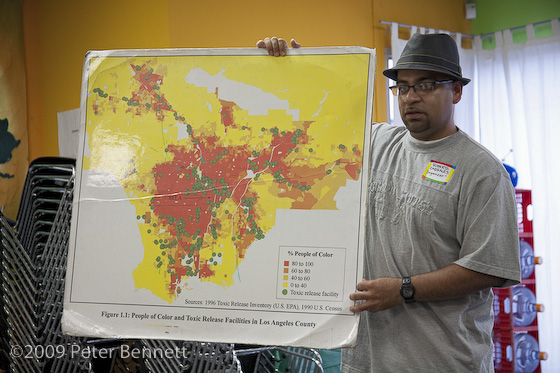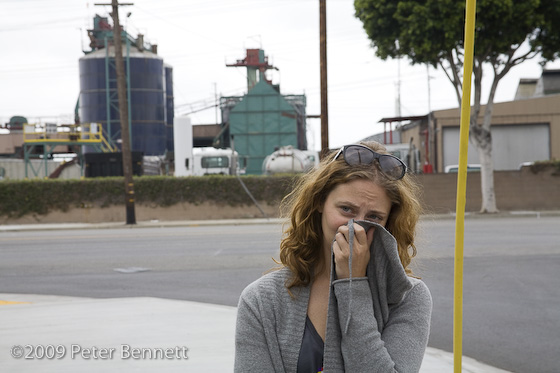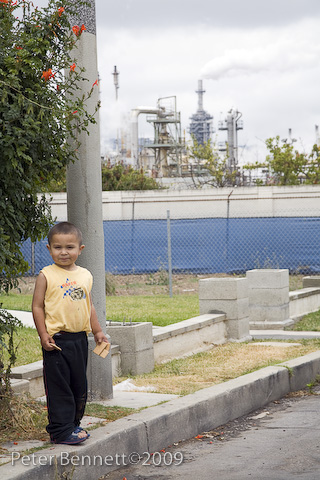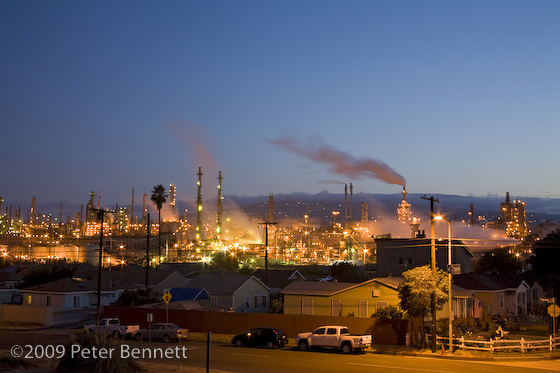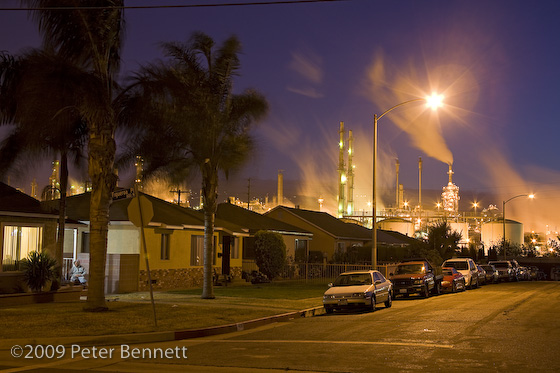Toxic Tour
Last year I spent a day taking the Toxic Tour, far removed from anything you would take at Universal Studios, this illuminating, and sometime nose burning journey is offered a few times a year by CBE – Communities for a Better Environment. It was a strange and fascinating day which included visits to chemical sites, refineries and brownfields, which are abandoned or underused industrial and commercial facilities. Don’t bring the kids!
CBE’s focus is on environmental health and justice, whereby they offer legal assistance, research and organizing help to poor and working class communities of color that suffer from environmental pollution and toxins due to proximity to industrial polluters. In fact shortly after arriving we were shown a map of Los Angeles with neighborhoods broken down by people of color and toxic facilities. I’m sure you can guess how many toxic sites were located in Malibu and Brentwood compared to South Central. The only thing that was surprising was how staggeringly disproportionate it truly was. CBE’s southern California headquarters is located in Huntington Park, right next to Vernon, the most industrialized city in the United States. Whereas Vernon is almost completely industrialized (it has a population of 91 according to the last Census), Huntington Park is a very residential community, and its proximity to Vernon and its emissions has given it the unfortunate nickname of "Asthma Town" due to the high incidence of respiratory illness afflicting its residents.
We spent most of the morning with our tour guide, Roberto Cabrales, viewing a number of successful examples of CBE and the local residents kicking out and shutting down toxic facilities in and around Huntington Park, Vernon, Maywood and Bell gardens, all communities a short distance from the downtown Los Angeles. It was a gray day, not the best for picture taking, which was fine, as it is sometimes hard to listen and shoot at the same time. The day ended in Wilmington, an area in San Pedro, near Long Beach, that some people might recognize as the town along the 110 freeway with the gargantuan oil refinery in the shadow of Rancho Palos Verdes. As someone who grew in New York City and spent way too many trips holding my nose as I passed by the oil refineries in Elizabeth, NJ, I can say that this one gives anything I have seen a run for its money.
The tour definitely saves the most dramatic for last. Where most of the examples we had seen were closed sites, the situation in Wilmington is ongoing, and for me the most striking thing was how close the residential houses were to the refinery. Street after street of modest, but nice single-family homes were literally a stones throw away from the belching smokestacks of the facility. Children played on the streets and people carried on with normal neighborhood activities as they would anywhere, except the background was not some mountain range, lake or even a mall, it was a giant, active oil refinery.
The dramatic juxtaposition of the homes next to the refinery was worth another trip, so I waited a few days for clearer weather and returned in late afternoon. As I was setting up my camera on an embankment next to the freeway, a van pulled up with several young men. The driver leaned out his window and asked if I was with the press. Now the press is not always welcome, but it can lend some legitimacy to some situations, and since I do carry LA County press credentials, I replied that I was. The question I received was not the obvious one I expected about when someone was going to do something about the stinky oil refinery in the neighborhood, but rather he wanted to know if I was there to do a story about trees the city had planted along the embankment that I was on. It seems the trees were planted a little while back and no one has come back to care for them. I took a glance at the sickly looking saplings he was referring to and said that I was sorry, but no. I think I mumbled something about the refinery, at which point he became disinterested and drove off.
I stood there wondering how someone could care more about these neglected trees than the more blatant health hazard of the refinery. Not that caring about the trees isn’t a legitimate concern, but relative to the greater danger, it made no sense. But then again living in this neighborhood and the nearby streets made no sense to me either, and yet this type of scenario is repeated thousands of times around the country and the world. Why do people live next to or near toxic sites? Much of the time they have no choice, poverty or the necessity of a nearby job limit choices. But these were nice lower middle class houses that many people would normally be happy to call their home.
There is no one answer I suppose, a combination of denial mixed in with the desire to own an affordable home (this area is definitely below market value), and possibly a certain resignation to the inevitability of that toxins are everywhere, so if this doesn’t get you, something else will. There is certain amount of truth to that, but I would say that it is still a relative case.
The Toxic Tour is given both in Los Angeles (the next one is May 15) and at CBE’s other headquarters in Oakland.
